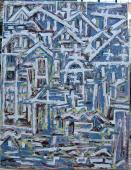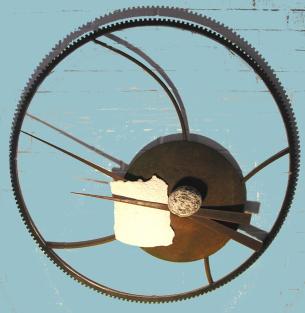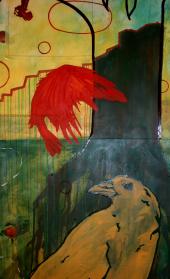The recently closed show at the Quad City International Airport art gallery featured nearly 50 stunning works: the serigraphy of Karen Blomme, the metal works of Tom Lytle, and the oil paintings and constructed boxes of Heidi Hernandez. I have exhibited with all three artists and have always been impressed by how their works strongly define the character of an exhibition.
While a handful of pieces are charged with exploratory energy, many of the works are more predictable progressions or refinements of previous visual explorations.
 While the work of Blomme and Lytle (both established area artists) seeks to cultivate visual and conceptual territories that they have already "claimed" with previous imagery, Hernandez (a younger, up-and-coming artist) is more vigorously exploring the "unknown" to find her own territory.
While the work of Blomme and Lytle (both established area artists) seeks to cultivate visual and conceptual territories that they have already "claimed" with previous imagery, Hernandez (a younger, up-and-coming artist) is more vigorously exploring the "unknown" to find her own territory.
Blomme typically builds her works with multiple layers of silk-screened images. These denser passages can have the unsettling visual sensation of watching a TV when someone with a shorter attention span holds the remote control. However, she wisely balances this muddied chaos with crisper images and cleaner hues, which provide a welcomed respite.
The major strength of serigraphy (silk-screening) is the ability to reproduce the same image hundreds if not thousands of times. That reproducibility is also serigraphy's Achilles' heel: Repetition without variety can become monotony. A way that Blomme has honed her technique is to cut apart and reassemble several prints of the same image to form a new one. This allows her new options for selection, placement, and proportion.
Two excellent examples of this newfound "image freedom" are the side-by-side works Pink NOLA and Blue NOLA. They each form a shallow and complex space of telephone poles, rooftops, crosses, windows, and an occasional dome. The tightly woven vertical spaces on the top three-quarters of either image quickly melt into a morass of looser horizontal strokes representing the flood.
Blomme's use of collage with her serigraphs allows her to construct denser yet cleaner images than some of her earlier works. They are her most sophisticated, refined, and successful pieces, and they capture the ubiquitous chaos of New Orleans - a town that even before Hurricane Katrina looked like a frat party no one bothered to clean up.
 Tom Lytle's metal sculptures often play lanky, nearly linear elements - such as arms and legs - against visually heavier, sometimes bulbous, heads and torsos. His works can be favorably compared to the long and sinewy figures of Swiss sculpture Alberto Giacometti, with Lytle placing more emphasis on the torsos and heads.
Tom Lytle's metal sculptures often play lanky, nearly linear elements - such as arms and legs - against visually heavier, sometimes bulbous, heads and torsos. His works can be favorably compared to the long and sinewy figures of Swiss sculpture Alberto Giacometti, with Lytle placing more emphasis on the torsos and heads.
Stalker, One of Lytle's most striking works, is a small, free-standing bird with a long beak, hunched over the water waiting to pluck an unseen morsel. Lytle has created a superb tension between the strong upward diagonal thrust of the legs and the curving, downward counter-thrust of the beak. The tail and body of the bird add some sense of mass to help soften these sharp linear movements.
In addition to Lytle's dynamic juxtapositions of slender lines and thick masses, he also pays strong attention to color and texture interactions. Best Two Out of Three Rock, Paper, Scissors is a work with several outwardly stacked layers of materials culminating in a wad of pink lint-like paper being pinched at the intersection of two chopstick forms, all underneath a small textured rock. The active color dialogue between the green patinas of the underlayer of metal and the pink wad of paper, and the push and pull between rough, crusty, soft, and smooth demonstrate his profound understanding of balance.
 Beyond the satisfyingly disturbing tension between saccharine nostalgia, playful interactions of colors with crisp, simple shapes, and an almost omnipresent sense of menace, there is a feisty spirit that comes through in Heidi Hernandez's work. She has two related bodies of work in the exhibit: her paintings (which frequently have collage elements) and her constructed "shadow" boxes (which are three-dimensional collage pieces).
Beyond the satisfyingly disturbing tension between saccharine nostalgia, playful interactions of colors with crisp, simple shapes, and an almost omnipresent sense of menace, there is a feisty spirit that comes through in Heidi Hernandez's work. She has two related bodies of work in the exhibit: her paintings (which frequently have collage elements) and her constructed "shadow" boxes (which are three-dimensional collage pieces).
Red Dress is an example of Hernandez's paintings expanding into new directions. The background is dominated by a vanilla-pudding yellow with sky-blue birds perched on twigs rhythmically placed like a wallpaper pattern. Some of those "background" birds have collage fragments of children's heads, hands, etc.
Numerous red and blue circles surround two blue figures (a boy and a girl) near the center. Between the two children is a partial figure of a red dress with polka-dot trim - visually reminiscent of a dress pattern, but with hands still attached. Hernandez has frequently employed collage in her work, but it used to be more of a background bonus; it is becoming an integral foreground element.
Where Hernandez seems to be exploring new territory is with her constructed boxes full of dolls, pictures, and ephemera. She has exhibited boxes before, which echoed some motifs within her paintings, but the boxes were heavily reliant on the nearby paintings to function to their fullest. More than half of Hernandez's works in this show are these boxes, and they have become their own entities.
The Moon Is a Balloon is essentially a diptych with a round window near the top of the box and a square window at the bottom. A stern yellow face (the moon) with a halo of red discs on the glass dominates the upper window. The more active bottom window has two red and white toy figures in front of a series of machine components and several strings hanging from the hovering moon. The figures could be children who just released their tethered moon of wonder, innocence, and imagination, as adulthood and the mechanical gears of being "part of the machine" start to replace childhood fantasy.










